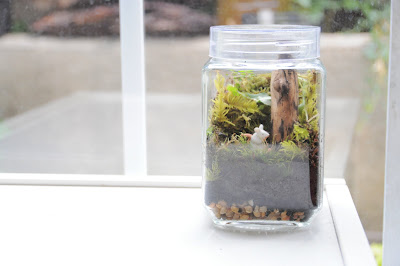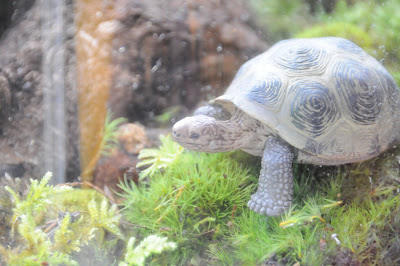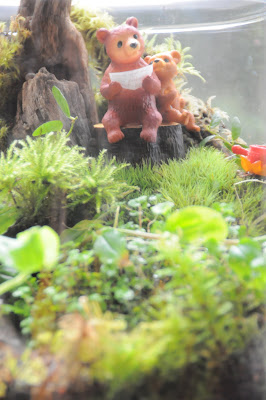
Monday, June 27, 2011
Thursday, June 23, 2011
Tuesday, June 14, 2011
Terrarium care instructions
terrarium care instructions
care instructions
place your terrarium within 10 feet of a window without exposing it to more than 1 hour of direct sunlight a day. be careful of placing directly in south facing windows. in offices, fluorescent lighting should provide the proper color range for good plant growth, but can be supplemented with a desk lamp if necessary. the key is to watch your terrarium closely until you understand it’s drying pattern. Feel the soil about an inch or so near a plant, if the soil is damp, it isn’t time to water yet. too much watering can be worse for the plants than too little.
Dos, Don’ts, and Personal Confessions
:Despite its reputation as a shade plant, once it’s inside your house, moss probably wants more sunlight than you thought. Try to aim for 5-8 hours of indirect sunshine a day. Rooms that you’d describe as "sunny" are best, but windowsills with full sun are death. DEATH. It’s like being in a closed car in August. You wouldn’t like it, and neither does your terrarium.
cactus + succulents
check often to see if plant is showing signs of stress i.e. changing colors, shriveling, changing shape... water 3-4 drops per plant once a month. every 6 months, fertilize with 1/2 strength liquid fertilizer for cactus and succulentsThe water cycle in a terrarium is very similar to the process that occurs in nature. The evidence of this continuous cycle can be seen in several ways. In a properly constructed terrarium enclosure, moisture will appear as condensation on the inner surfaces of the enclosure. Gravity will cause the condensed moisture to run back down to the soil. Moisture also will condensate on the surface of the plants in a process referred to as canopy interception...Part of the terrarium water cycle involves the plants through the process of transpiration where water is expelled from the plant. Continuing the cycle, the water expelled from plant cell evaporates, condenses and precipitates all in the confines of your terrarium.
Terrariums can be extremely easy to care for if they are a balanced and complete system. If there is a proper water cycle and enough air circulation- an ecosystem can thrive even in a completely sealed system. When a terrarium reaches a degree of "self-sufficiency" it can be extremely easy to care for- and may need water and a quarter-turn in the sunlight only once every few months or so. However- if moss exhibits signs of dehydration or disease the system can need careful water, management and maintenance. A healthy terrarium requires proper moisture levels- which an open container may not provide. If a terrarium container is mostly open- it would take constant humidity or moisture to keep most mosses alive. This is most easily achieved by keeping a lid on a brandy-sniffer or fishbowl shaped terrarium. A lid can be a fitted top or even something akin to a dinner plate or a piece of plexiglass. Sphagnum or peat moss as available in most craft stores- as a dried but live moss. You may have seen this dried moss stuffed on top of silk plant arrangements or worse- spray painted green and advertised as "dried moss" in a terrarium. However if given proper lighting and water this craft moss will come "back to life" and will grow green and begin sprouting. You can propagate this moss yourself at home by misting it and keeping it in an incubation terrarium. If it is given a chance to really thrive- this plant becomes the almost grassy-looking moss you see in many terrariums for sale. It just takes a little patience, some creativity and some insight into what moss requires for optimum growing conditions.Often this means high acidity, constant moisture, some degree of air circulation and a somewhat enclosed system to protect the moss from insects, mold or rotting.
place your terrarium within 10 feet of a window without exposing it to more than 1 hour of direct sunlight a day. be careful of placing directly in south facing windows. in offices, fluorescent lighting should provide the proper color range for good plant growth, but can be supplemented with a desk lamp if necessary. the key is to watch your terrarium closely until you understand it’s drying pattern. Feel the soil about an inch or so near a plant, if the soil is damp, it isn’t time to water yet. too much watering can be worse for the plants than too little.
Dos, Don’ts, and Personal Confessions
:Despite its reputation as a shade plant, once it’s inside your house, moss probably wants more sunlight than you thought. Try to aim for 5-8 hours of indirect sunshine a day. Rooms that you’d describe as "sunny" are best, but windowsills with full sun are death. DEATH. It’s like being in a closed car in August. You wouldn’t like it, and neither does your terrarium.
cactus + succulents
check often to see if plant is showing signs of stress i.e. changing colors, shriveling, changing shape... water 3-4 drops per plant once a month. every 6 months, fertilize with 1/2 strength liquid fertilizer for cactus and succulentsThe water cycle in a terrarium is very similar to the process that occurs in nature. The evidence of this continuous cycle can be seen in several ways. In a properly constructed terrarium enclosure, moisture will appear as condensation on the inner surfaces of the enclosure. Gravity will cause the condensed moisture to run back down to the soil. Moisture also will condensate on the surface of the plants in a process referred to as canopy interception...Part of the terrarium water cycle involves the plants through the process of transpiration where water is expelled from the plant. Continuing the cycle, the water expelled from plant cell evaporates, condenses and precipitates all in the confines of your terrarium.
Terrariums can be extremely easy to care for if they are a balanced and complete system. If there is a proper water cycle and enough air circulation- an ecosystem can thrive even in a completely sealed system. When a terrarium reaches a degree of "self-sufficiency" it can be extremely easy to care for- and may need water and a quarter-turn in the sunlight only once every few months or so. However- if moss exhibits signs of dehydration or disease the system can need careful water, management and maintenance. A healthy terrarium requires proper moisture levels- which an open container may not provide. If a terrarium container is mostly open- it would take constant humidity or moisture to keep most mosses alive. This is most easily achieved by keeping a lid on a brandy-sniffer or fishbowl shaped terrarium. A lid can be a fitted top or even something akin to a dinner plate or a piece of plexiglass. Sphagnum or peat moss as available in most craft stores- as a dried but live moss. You may have seen this dried moss stuffed on top of silk plant arrangements or worse- spray painted green and advertised as "dried moss" in a terrarium. However if given proper lighting and water this craft moss will come "back to life" and will grow green and begin sprouting. You can propagate this moss yourself at home by misting it and keeping it in an incubation terrarium. If it is given a chance to really thrive- this plant becomes the almost grassy-looking moss you see in many terrariums for sale. It just takes a little patience, some creativity and some insight into what moss requires for optimum growing conditions.Often this means high acidity, constant moisture, some degree of air circulation and a somewhat enclosed system to protect the moss from insects, mold or rotting.
Friday, June 10, 2011
Sunday, June 5, 2011
Wednesday, June 1, 2011
Subscribe to:
Comments (Atom)




















































